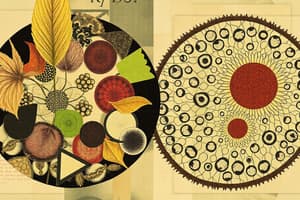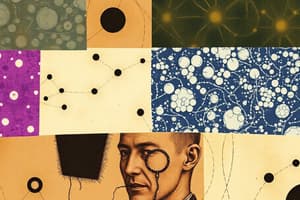Podcast
Questions and Answers
What structure is characteristic of nerve cells?
What structure is characteristic of nerve cells?
- Chloroplasts
- Vacuoles
- Cell wall
- Cell body (correct)
Which type of tissue is specialized for absorption and secretion?
Which type of tissue is specialized for absorption and secretion?
- Connective tissue
- Muscle tissue
- Epithelial tissue (correct)
- Nervous tissue
Which of the following is NOT a type of connective tissue?
Which of the following is NOT a type of connective tissue?
- Cartilage
- Ligaments
- Skeletal muscle (correct)
- Blood
Which type of muscle tissue is involuntary?
Which type of muscle tissue is involuntary?
What are ova or egg cells characterized as?
What are ova or egg cells characterized as?
Which component holds muscles to bones?
Which component holds muscles to bones?
Which cell type is responsible for the conduction of impulses?
Which cell type is responsible for the conduction of impulses?
What type of muscle cells allow for movement in the stomach without conscious control?
What type of muscle cells allow for movement in the stomach without conscious control?
Which of the following structures is found only in plant cells?
Which of the following structures is found only in plant cells?
What structure is present in both plant and animal cells?
What structure is present in both plant and animal cells?
Which organelle is responsible for energy production in both plant and animal cells?
Which organelle is responsible for energy production in both plant and animal cells?
Which of the following is a type of tissue found in humans?
Which of the following is a type of tissue found in humans?
Which of these organelles is not found in animal cells?
Which of these organelles is not found in animal cells?
What is the primary function of ribosomes in cells?
What is the primary function of ribosomes in cells?
Which structure regulates the entry and exit of substances in all cells?
Which structure regulates the entry and exit of substances in all cells?
Which of the following statements is correct regarding centrioles?
Which of the following statements is correct regarding centrioles?
What type of muscle is also referred to as visceral or smooth muscle?
What type of muscle is also referred to as visceral or smooth muscle?
Which type of muscle is controlled voluntarily and appears striated?
Which type of muscle is controlled voluntarily and appears striated?
What are the main functions of motor neurons?
What are the main functions of motor neurons?
Which type of meristem is responsible for the increase in the length of stems and roots?
Which type of meristem is responsible for the increase in the length of stems and roots?
What distinguishes permanent tissues from meristematic tissues in plants?
What distinguishes permanent tissues from meristematic tissues in plants?
Which type of neuron is responsible for conveying impulses within the central nervous system?
Which type of neuron is responsible for conveying impulses within the central nervous system?
Which type of muscle is responsible for heart contractions and is striated in appearance?
Which type of muscle is responsible for heart contractions and is striated in appearance?
What characteristic is NOT true of skeletal muscle?
What characteristic is NOT true of skeletal muscle?
Flashcards are hidden until you start studying
Study Notes
Cell Structures in Plant and Animal Cells
- Cell Wall: Present in plant cells; provides structure and protection; absent in animal cells.
- Cell Membrane: Present in both plant and animal cells; regulates entry and exit of substances.
- Ribosomes: Found in both types of cells; essential for protein synthesis.
- Nucleus: Common in both plant and animal cells; controls cell activities and contains genetic material.
- Mitochondria: Present in both cell types; powerhouse of the cell, produces energy.
- Chloroplasts: Unique to plant cells; site of photosynthesis, converting sunlight into energy.
- Centrioles: Exclusive to animal cells; involved in cell division and formation of spindle fibers.
- Vacuole: Present in both; larger in plant cells, used for storage and maintaining turgor pressure.
- Golgi Apparatus: Found in both; modifies, sorts, and packages proteins and lipids for secretion.
- Endoplasmic Reticulum: Present in both; involved in the synthesis of proteins (rough ER) and lipids (smooth ER).
Human Cells and Their Functions
- Blood Cells: Comprise red blood cells, white blood cells, and platelets, floating in plasma; crucial for transport and immune response.
- Nerve Cells (Neurons): Specialized for impulse conduction, consisting of a cell body, axon, and dendrites.
- Skeletal Muscle Cells: Known as striated muscle cells; exhibit a striped appearance under a microscope, enabling voluntary movement.
- Ova (Egg Cells): Female sex cells produced by ovaries; essential for reproduction.
- Sperm Cells: Male sex cells produced by testes; vital for fertilization.
Types of Tissues in Animal Cells
- Epithelial Tissue: Composed of closely packed cells; lines cavities and surfaces, enabling absorption, secretion, and sensation.
- Connective Tissue: Supports and holds body parts together; includes ligaments (bone to bone), tendons (muscle to bone), and specialized types like cartilage and blood.
- Muscle Tissue: Responsible for movement; includes:
- Involuntary Muscle: Not consciously controlled, e.g., stomach muscles (smooth muscle).
- Voluntary Muscle: Under conscious control, e.g., skeletal muscle.
- Cardiac Muscle: Involuntary and striated, making up the heart.
Types of Neurons
- Motor Neurons (Efferent): Transmit impulses from the Central Nervous System (CNS) to muscles or glands.
- Sensory Neurons (Afferent): Carry impulses from sensory receptors to the CNS.
- Interneurons (Association Neurons): Connect various parts of the CNS, facilitating communication.
Plant Tissues
- Meristematic Tissues: Responsible for producing new cells; composed of undifferentiated cells; found in growth tips of roots and stems.
- Apical Meristems: Found at stem and root tips; responsible for length growth.
- Lateral Meristems: Located on the sides of stems and roots; responsible for width growth.
- Permanent Tissues: Composed of mature, differentiated cells; fulfill specific functions within the plant.
Studying That Suits You
Use AI to generate personalized quizzes and flashcards to suit your learning preferences.





